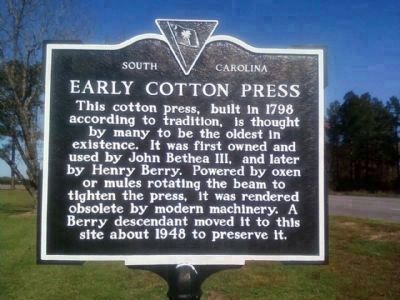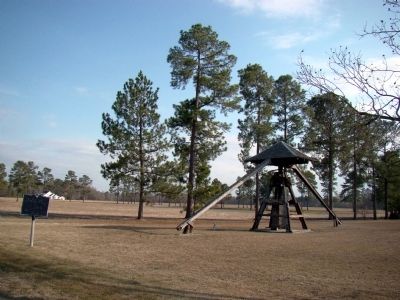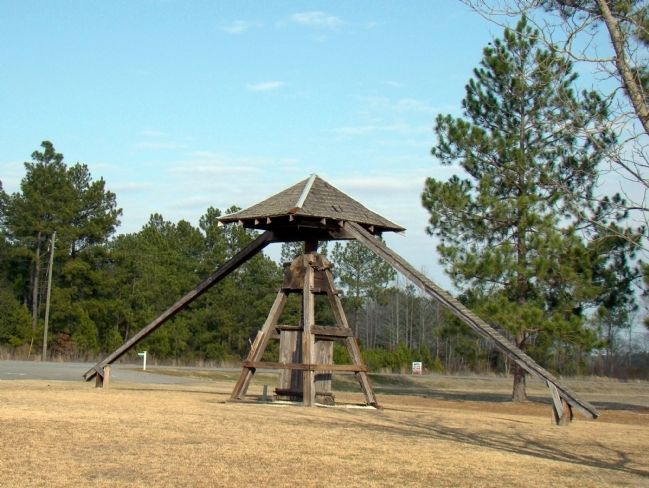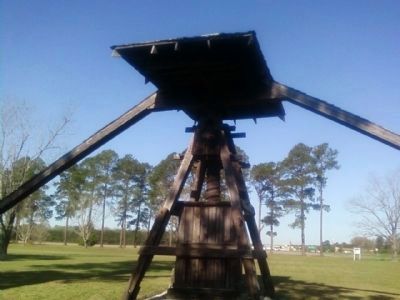Near Oak Grove in Dillon County, South Carolina — The American South (South Atlantic)
Early Cotton Press
Erected 1974 by Dillon County Historical Society. (Marker Number 17-3.)
Topics. This historical marker is listed in these topic lists: Agriculture • Animals • Industry & Commerce. A significant historical year for this entry is 1798.
Location. 34° 20.286′ N, 79° 31.452′ W. Marker is near Oak Grove, South Carolina, in Dillon County. Marker is on State Highway 38 near Exit 181 A (Interstate 95), on the right when traveling east. The cotton press is located on the ground of Bicentennial Farm, so named because is is located on a farm owned by the same family for over two centuries. Touch for map. Marker is in this post office area: Latta SC 29565, United States of America. Touch for directions.
Other nearby markers. At least 10 other markers are within 6 miles of this marker, measured as the crow flies. Catfish Creek Baptist Church (approx. 2.6 miles away); The Edwards House (approx. 5.1 miles away); Latta's Railroad Story (approx. 5.1 miles away); Latta Library: A Carnegie Library (approx. 5.1 miles away); The Latta Library (approx. 5.1 miles away); Dillon County Museum (approx. 5.1 miles away); Post Office and General Store (approx. 5.1 miles away); Robert Earl Atkinson, Sr. (approx. 5.1 miles away); Vidalia Academy (approx. 5.2 miles away); Latta Veterans Memorial Park (approx. 5.2 miles away).
Also see . . . National Register of Historic Places Nomination Form (1972). “Original location at ‘Berrys’ Crossroads,’ former site of sawmill and other plantation works, three miles west of Latta. Present location in open field ½ mile west of intersection of Routes 917 and 38.
“Built 1798 for baling ginned cotton, press constructed of pegged and doweled oak. Shingled roof attached to and covers chiseled oak screw 16 inches in diameter. Screw still in working condition. Two shingled booms hinged at roof. Four large doweled beams support and balance structure. Press box housed at center of beams.
“According to Walter F. Petty, F.A.I.A., press has ‘excellent joinery, especially fine chisel work on wood screw.’
“Original materials in entire structure except for minor repairs at base of legs and on shingled
roof.
“Statement of Significance. Significant in the field of Rural Industry as the only remaining cotton press of this era in South Carolina which used mule power. Although not now in use, it remains in excellent condition and illustrates the primary machine which baled ginned cotton.
“Built and located at ‘Berry’s Crossroads’ by Stephen Berry in 1798. Purchased and moved to its present location (½ mile west of intersection of Routes 917 and 38, not far from original site) in 1850 by an uncle of Mrs. John Calhoun Hayes to preserve as a structure identified with local industry and as a curiosity to passersby.
“Recorded October, 1961, for HABS Survey by Walter F. Petty, A.I.A., Committee on Preservation; William Keenan III, Preservation Officer, South Carolina Chapter. Mrs. John Calhoun Hayes owned the early cotton press at the time of the HABS Survey. According to Walter Petty, F.A.I.A., it is an excellent example of manual craftsmanship and ‘should be preserved as historic example of slave artisans work on plantation.’ All parts are hand carved and, except for several repairs, original material.” (Submitted on April 10, 2009.)
Credits. This page was last revised on February 2, 2020. It was originally submitted on April 9, 2009, by J. J. Prats of Powell, Ohio. This page has been viewed 1,861 times since then and 53 times this year. Photos: 1. submitted on March 26, 2011, by Stanley and Terrie Howard of Greer, South Carolina. 2, 3. submitted on April 10, 2009, by J. J. Prats of Powell, Ohio. 4. submitted on March 26, 2011, by Stanley and Terrie Howard of Greer, South Carolina.



